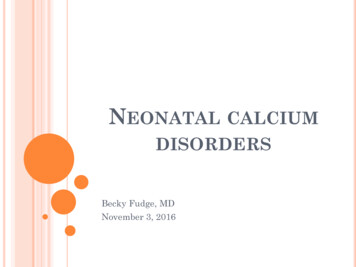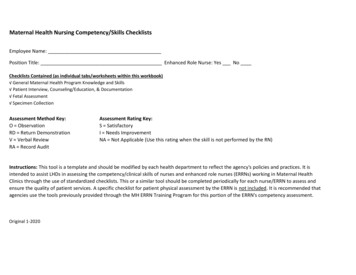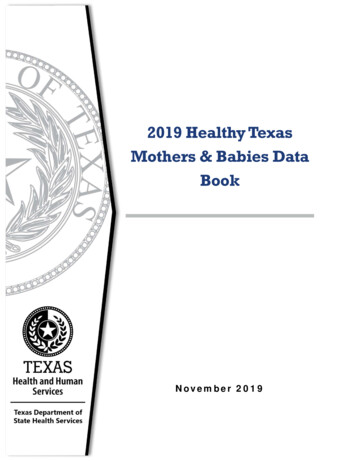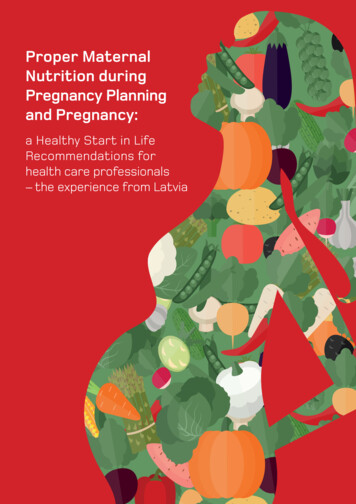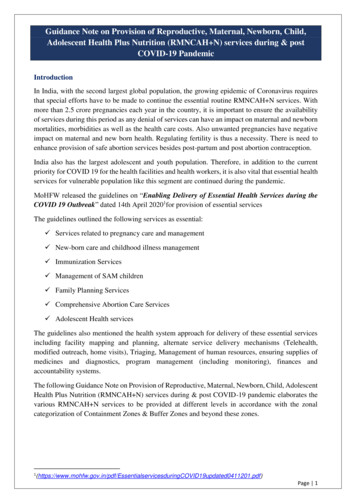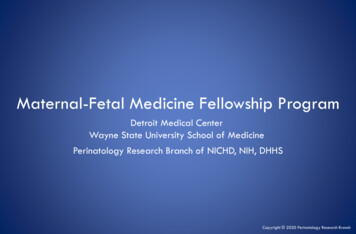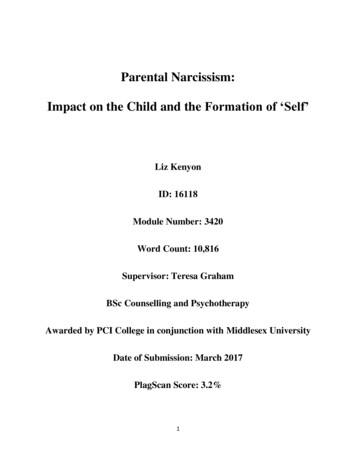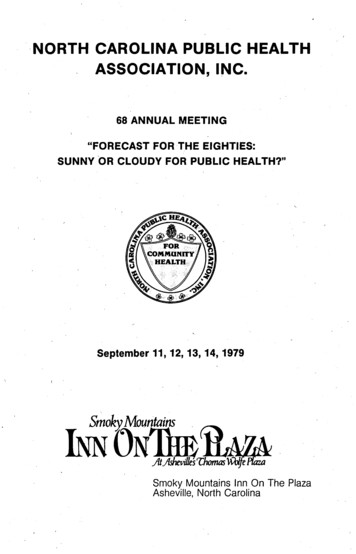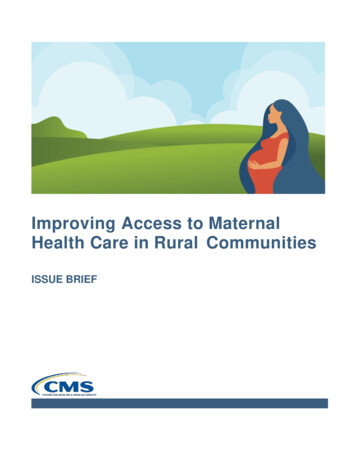
Transcription
Improving Access to MaternalHealth Care in Rural CommunitiesISSUE BRIEF
CONTENTSExecutive Summary . 1Introduction . 3Access to Maternal Health Care in Rural Communities . 63.1Before Pregnancy . 73.2During Pregnancy . 83.3After Pregnancy . 11Opportunities to Improve Access to Maternal Health Care in Rural Communities. 124.1Accessible: Delivers Care via a Multidisciplinary Workforce . 124.2Affordable: Reduces Financial Barriers for Mothers and Families. 154.3Risk-Appropriate: Exemplifies a High-Functioning Maternal Health System . 174.4High Quality: Provides Safe, Timely, Efficient, and Effective Care and Services . 184.5Patient-Centered: Values the Whole Person and Family . 194.6Innovative: Leverages Telehealth and Related Technology. 204.7Coordinated: Connects Women to Behavioral and Social Supports . 214.8Equitable: Provides High-Quality, Patient-Centered Care to All Women . 22Highlighted Examples: Improving Access to Maternal Health Care in Rural Communities. 25Conclusion . 29Appendix A. Distribution of Hospital Obstetric Unit Closures in Micropolitan and Noncore Counties,2004–2014 . 30Appendix B. Scope of Practice Among Maternal Health Providers . 31Appendix C. Summary of Six Case Studies . 33Appendix D. Acronyms List . 48Endnotes . 49Improving Access to Maternal Health Care in Rural Communities Issue Briefi
EXECUTIVE SUMMARYAcross the country and at every level of government there has been a growing focus on rural health. Atthe same time, rising maternal mortality rates and the disproportionate affect they have on Black,American Indian, and Alaska Native women is of great concern. Rural maternal health care is thereforean administration priority and the Centers for Medicare & Medicaid Services (CMS) has been focusedon improving rural maternal health outcomes. Specifically, CMS has aligned health policies to its RuralHealth Strategy and its new Rethinking Rural Health Initiative, released its first Medicaid and Children’sHealth Insurance Program (CHIP) Scorecard to evaluate state progress on maternal health outcomes,and is preparing to implement the recently enacted Improving Access to Maternity Care Act andPreventing Maternal Deaths Act. This issue brief was developed by CMS to provide backgroundinformation on the scope of this problem and to focus attention on the need for national, state, andcommunity-based organizations to collaborate on developing an action plan to improve access tomaternal health care and improve outcomes for rural women and their babies.A lack of access to high quality maternal health services in rural communities is the result of manyfactors including hospital and obstetric department closures, workforce shortages, and access to carechallenges arising from the social determinants of health which have contributed to disparities inmaternal health care for rural women and their babies. These access challenges can result in a numberof negative maternal health outcomes including premature birth, low-birth weight, maternal mortality,severe maternal morbidity, and increased risk of postpartum depression. These health disparities affectAmerican Indian and Alaska Native and women of color disproportionately. Since one in five Americanslive in a rural community, including approximately 18 million women of reproductive age, it is critical thatfederal, regional, state, local agencies and communities work together to improve access to high qualitymaternal health services in rural communities.Hospital closures: Since January 2010, more than 100 rural hospitals have closed, with adisproportionate share occurring in the South. Multiple factors contributed to these closures. Amongthem were higher rates of uninsured patients, large amounts of uncompensated care, financial distress,hospital size, and community poverty rates. Between 2004 and 2014, 179 rural counties lost or closedtheir hospital obstetric services. Consequentially, fewer than 50% of rural women have access toperinatal services within a 30-mile drive from their home and more than 10% of rural women drive 100miles or more for these services. These conditions affect access to care before, during, and afterpregnancy and are more pronounced in the Black and Hispanic communities, and disproportionatelyaffects low-income women.Access to care: Before pregnancy the health and wellness of a woman is critical to achieving safeoutcomes for her and her baby. Access to care is vital during this period because it allows providers toidentify, treat, and stabilize chronic conditions; address behavioral health needs; and, plan for a healthyand intentional pregnancy. During pregnancy a woman’s need for access to maternal health servicesincreases. Prenatal care can reduce the risk of pregnancy complications for both the mother and child.After pregnancy women must establish or reestablish their well-woman care. At each point along thiscontinuum women in rural communities experience challenges and barriers.Insurance coverage: Medicaid is the nation’s single largest payor of perinatal care and is especiallyimportant in rural areas. In 2017, Medicaid paid for 43% of all births in the United States (1.7 of the 3.9million births) and an estimated 50-60% of births in rural areas.1,2 However, many women covered byMedicaid lose their coverage 60 days postpartum. This loss of health coverage increases the likelihoodthat these women will receive inadequate or no health services, increases their risk of morbidity andImproving Access to Maternal Health Care in Rural Communities Issue Brief1
mortality, and increases their likelihood of receiving no support for conditions that emerge after the 60day period. However, the loss of Medicaid eligibility is a qualifying event to enroll in Exchangecoverage, and the president's 2020 budget proposes giving states the authority to allow mothers withsubstance abuse disorder to stay eligible for Medicaid for one year after giving birth.Workforce supply and distribution: Maternal health care is delivered by a vast array of providers—specialty providers; primary care providers, including advanced practice nurses; nurses; communityhealth workers; and doulas. Each of these health care professionals plays a critical role in providingmaternal health care before, during, and after pregnancy. However, there is a shortage of maternalhealth care providers in rural and urban areas. By 2020, it is estimated that the US will have a shortageof 6,000-8,800 obstetricians and gynecologists (OB-GYNs) with a projected increase in that shortage to22,000 by 2050. The shortage is more severe in rural areas, where many counties do not have apracticing OB-GYN. Although family physicians are the largest group of rural obstetrical providers,midwives are another important source of maternal health services in rural areas.3 While midwivescurrently attend less than 10% of all births in the US, they attend over 30% of deliveries in ruralhospitals. There are still barriers to the practice of midwifery across the country even though midwiferyhas proven to be a safe and cost-effective mode of maternal health care.4, 5, 6 Although some stateshave limits on the services covered, all states provide coverage of certified nurse midwife servicesthrough Medicaid. In contrast, many private insurance plans do not cover services provided bymidwives or offer only limited coverage. Other providers that deliver critical services to women before,during, and after pregnancy, including behavioral health providers and dentists, are also difficult toaccess in rural communities.The lack of adequate, high quality maternal health care in rural communities has led many ruralcommunities to find creative and innovative solutions to address some of the maternal health caredelivery challenges in their communities. These innovative solutions include opportunities to improveaccess to a skilled maternal health workforce by expanding training of maternal health providers in ruralareas, incentivizing maternal health providers to practice in rural areas, leveraging the existing healthcare workforce, and standardizing scope of practice laws for maternal health providers. Some programsare working to make maternal health care more affordable by paying for the cadre of maternal healthproviders, expanding and extending insurance coverage, unbundling postpartum services, andestablishing accountable care organizations covering maternal health services. Others haveimplemented programs to increase access to risk-appropriate, quality care; to establish frameworks forhigh-quality care; and, to address patient -centered care and care coordination. By working together toensure widespread dissemination and adoption of these programs, we will move closer to ending thegap in maternal health disparities and ensure that all rural women and their babies have better maternalhealth outcomes.Improving Access to Maternal Health Care in Rural Communities Issue Brief2
INTRODUCTIONIn an ideal maternal health system, all women would have access to comprehensive, seamless medicalcare with links to behavioral, economic, and social supports. Additionally, they would be engaged withthis system before, during, and after pregnancy. Across the United States, many women are notreceiving care in this ideal system, and women in rural communities face unique challenges that makeit harder for them to reach this ideal or any care at all in some cases. Because maternal health care is agrowing concern in rural America, rural maternal health care is an administration priority and theCenters for Medicare & Medicaid Services (CMS) has been focused on improving rural maternal healthoutcomes.As part of its Rethinking Rural Health Initiative, CMS released its first Rural Health Strategy in 2018. Byapplying a rural lens, CMS works to have new health policies and initiatives positively impact ruralcommunities. As an example, the agency finalized improvements to the accuracy of Medicare payments tolow wage hospitals so they can increase what they pay their workers, and help ensure patients includingthose living in rural areas, continue to have access to high-quality, affordable healthcare.7 Other CMS ruraland maternal related activities have included, the recent release of the first Medicaid and CHIP Scorecardto evaluate state progress on health outcomes and determine return on investment. The Scorecardincludes a measure related to postpartum care and may eventually include other maternal and infanthealth outcomes. Furthermore, CMS looks forward to implementing the newly enacted Improving Accessto Maternity Care Act, which ensures that the National Health Service Corps sends OB-GYNs to areas ofgreatest need, as well as the Preventing Maternal Deaths Act, which authorizes the Centers for DiseaseControl and Prevention (CDC) to support state and tribal maternal mortality review committees (MMRCs).Although CMS has made great strides to improve rural maternal and child health outcomes, there is stillmuch to be accomplished. CMS developed this issue brief to increase understanding and awareness ofthe difficulties women in rural communities face and to highlight the need for a coordinated andcollaborative development of a strategic plan to improve access to maternal health care and healthoutcomes. This issue brief focuses on access to care for women in rural communities before, during,and after pregnancy. It provides an overview of the challenges they encounter accessing maternalhealth care, describes opportunities to address these challenges within the maternal health system,and provides examples of programs that are overcoming barriers to improve access and quality in ruralmaternal health care.Since January 2010, more than 100 rural hospitals have closed, with a disproportionate share occurringin the South.8, 9 These closures were the result of multiple factors including higher rates of uninsuredresidents, higher amounts of uncompensated care, financial distress, hospital size, and communitypoverty rates.10, 11 Although many rural hospitals remain open, some have discontinued certainspecialty service lines, including obstetric and gynecologic services. Between 2004 and 2014, 179 ruralcounties experienced closures/loss of hospital obstetric services (Figure 1).12 Also during this time,more than half of the rural counties in the US either had no hospital obstetric services or lost them(Appendix A).13 Low birth volumes, low revenue levels due to payor mix (e.g., high rates of Medicaidcoverage), difficulty recruiting and maintaining skilled maternal health care providers (e.g.,Improving Access to Maternal Health Care in Rural Communities Issue Brief3
obstetricians, labor and delivery nurses, obstetric anesthetists), and concerns regarding the high cost ofmalpractice insurance have all contributed to obstetric unit closure in rural hospitals.iHospital Obstetric Services in Rural Counties, 2004–2014Source: P Hung, C Henning-Smith, M Casey, and K Kozhimannil. Access to Obstetric Services in Rural Counties Still Declining, With 9Percent Losing Services, 2004–14. Health Aff (Millwood). 2017 Sep 1; 36(9): 1663-1671.These closures and resulting lack of services have affected rural women’s access to and timeliness inreceiving maternal health care. Nearly half of all rural counties in the US do not have a hospital withobstetric services.14 Subsequently, fewer than 50% of rural women have access to perinatal serviceswithin a 30-minute drive of their homes, and more than 10% of rural women drive 100 miles or more forsuch services.15 Additionally, linkages to behavioral health care and social services that help promotehealthy pregnancies and healthy outcomes for rural women are inadequate.16, 17 These challenges aregreater for racial and ethnic minority women living in rural communities, as closures were more likely tooccur in communities with a higher percentage of Black, Hispanic, and unemployed residents.18These gaps in maternal health care clearly affect access to labor and delivery services, but they alsoaffect access to care before, during, and after pregnancy, and comprise one set of factors associatedwith a range of infant and maternal health outcomes in rural America, such as maternal mortality. TheCDC defines pregnancy-related deaths as the death of a woman while pregnant or within 1 year of theend of a pregnancy –regardless of the outcome, duration or site of the pregnancy–from any causerelated to or aggravated by the pregnancy or its management, but not from accidental or incidentalcauses.19 Using maternal mortality as one proxy for overall maternal health, there are 29.4 maternaldeaths per 100,000 in the most rural areas versus 18.2 in urban areas.20 Social factors such as income,iThere are multiple definitions of rural in use across the federal government. In this issue brief, we define rural as counties classified by theOffice of Management and Budget (OMB) as micropolitan (statistical areas have a population of 10,000 or more but less than 50,000) andnonmetropolitan (areas outside of Core Based Statistical Areas).Improving Access to Maternal Health Care in Rural Communities Issue Brief4
education, housing, food, transportation and social support, commonly referred to as the socialdeterminants of health, also affect a wide range of health, functioning, and quality-of-life outcomes andrisks. Addressing social determinants of health may be especially difficult in rural areas, which tend tohave fewer educational and job opportunities, older housing, and limited access to healthy foods.These factors and a lack of access to health services contributes to disparities in health.21,22,23 Figure 2provides a social determinants of health framework that illustrates how maternal health is a result of thestructural, behavioral, biological, psychological, systemic, and socioeconomic circumstances thatoperate across a woman’s life and across generations. It also illustrates the critical role the maternalhealth care system plays in mitigating risk and affecting outcomes. Ideally, maternal health care is: riskappropriate; delivered by a skilled workforce; coordinated or integrated with behavioral, economic, andsocial supports; affordable for mothers, and families; and equitable.Social Determinants of Maternal HealthSources: Manyazewal, T. Using the World Health Organization health system building blocks through survey of healthcare professionals todetermine the performance of public healthcare facilities. Archives of Public Health. 2017 Dec;75(1):50. Solar, O, Irwin, A. A ConceptualFramework for Action on the Social Determinants of Health. Social Determinants of Health Discussion Paper 2 (Policy and Practice).Retrieved from: tualframeworkforactiononSDH eng.pdf.Improving Access to Maternal Health Care in Rural Communities Issue Brief5
ACCESS TO MATERNAL HEALTH CARE IN RURALCOMMUNITIESOne in five Americans live in a rural community, including approximately 18 million women ofreproductive age, and nearly half a million babies are born in rural hospitals each year.24,25,26 Medicaidplays a large role in covering costs of deliveries in both rural and urban areas and is the single largestpayor of perinatal care. In 2016, Medicaid paid for 43% of all births in the US.27 Rural communities tendto have higher rates of Medicaid coverage than urban communities, and rate differences varysignificantly across states.28A lack of access to maternal health care can result in a number of negative maternal health outcomesincluding premature birth, low-birth weight, maternal mortality, severe maternal morbidity, andincreased risk of postpartum depression. Poor or absent prenatal care can contribute to theseoutcomes. Women in rural communities are more likely to begin prenatal care late. Less formaleducation, lower health literacy, unplanned pregnancies, and poor transportation have all beenassociated with late prenatal care.29 In both rural and urban areas, there are persistent disparities inmaternal health including prenatal care and maternal morbidity and mortality by race and ethnicity, andsocioeconomic status. 30, 31,32,33,34,35 Research examining racial and ethnic health disparities withinrural areas is limited. That said, the evidence that is available shows that rural racial and ethnic minoritypopulations face substantial health, access to care, and lifestyle challenges.Addressing health disparities between women in rural and urban areas and by race and ethnicityrequires addressing a woman’s health needs before, during, and after pregnancy.36 This includesmaking sure women have adequate health coverage, access to family planning and routine check-ups,as well as mental and oral health care and social supports. Table 1 highlights the vital maternal healthsystem elements before, during, and after pregnancy. Women in rural areas have less access to theseservices due to several barriers discussed in Section 4.Vital Maternal Health System Elements Before, During, and After PregnancyDuring PregnancyMaternal Health lLabor &DeliveryPostpartumXXXXXXHealth Insurance CoverageXFamily PlanningXRoutine or Regular CheckupsXXIdentification and Support for HighRisk ConditionsXXMental Health and Substance UseScreening, Treatment, RecoverySupport, and Wrap-around CareXXOral Health ServicesXXGenetic Screening and CounselingXXImproving Access to Maternal Health Care in Rural Communities Issue BriefXXXXXXXX6
During PregnancyMaternal Health ate Labor andDelivery ServicesLabor &DeliveryAfterPregnancyPostpartumXBreastfeeding SupportXSocial ServicesXXInitiatives to Decrease Disparities inHealth CareXXXXXXXXXThe data in Table 1 summarizes the information presented in Section 3; therefore, the contributing sources are listed in the narrative below.3.1Before PregnancyBefore pregnancy, the health and wellness of a woman is critical to achieving safe outcomes for herand her baby. Access to care is critical during this period because it allows providers to identify, treat,and stabilize chronic conditions; address behavioral health needs; and plan for a healthy and intentionalpregnancy.37Key health risks during this period are generally ongoing or chronic health conditions and behaviorsthat impact the woman during and after pregnancy, increase the risk of maternal morbidity andmortality, and impact the child both in utero and after birth. These health risks include chronic diseasessuch as hypertension, cardiac disease, obesity, and asthma; behavioral health such as tobacco use,substance use disorders, and mental health concerns; exposure to violence; and unintendedpregnancy.38 Lack of insurance during this time period is particularly deleterious since affordability ofcare is a barrier to access.39Before pregnancy vital health system services to address problems associated with getting pregnant orhealth conditions associated with carrying a baby to full-term include:40 Health coverage to support access to care. Family planning for appropriate birth spacing and prevention of unintended pregnancies. Routine or regular checkups. Mental health and substance use screening, treatment, recovery, and wrap-around care to reducetobacco use, alcohol misuse, and substance use, and to provide mental health support. Oral health services to improve oral health and reduce the risk for premature and low-birthweightbabies. Identification and support for high-risk conditions to provide appropriate services to manageconditions that impact pregnancy outcomes. Social services (e.g., family support, economic services, violence prevention, nutrition support) toreduce or prevent risk factors such as exposure to violence or poor nutrition and to support stabilityin employment and housing. Initiatives to decrease disparities in health care.Improving Access to Maternal Health Care in Rural Communities Issue Brief7
For women in rural areas, both a lack of health insurance and less access to consistent primary,specialty, and supportive services reduce the chances that they will receive these vital health services.Many women do not have health coverage or access to health care due to cost and other barriers untilbecoming pregnant, which is a qualifying event for Medicaid enrollment.41 A lack of health insurance,combined with lower adherence to treatments and regimens, can affect women’s health and pregnancyoutcomes.42,43,44,45,46Women of color in rural communities have less access to pre-pregnancy services, and data show theyare more likely to become pregnant without receiving adequate previous health care.47,48,49 In addition,women of color in rural areas reported experiencing discrimination and/or feelings of stigmatizationwhen accessing maternal health care services, resulting in health care avoidance. This furtherexacerbates the risks to overall maternal health experienced by women of color living in rural areas.50Although the focus of this issue brief is on women living in rural communities, it is worth noting thatmany of these barriers are also experienced by women of color living in urban areas.3.23.2.1During PregnancyDuring the Prenatal PeriodDuring the prenatal period, a woman’s need for access to maternal health services increases. Thisperiod includes the prenatal period, labor and delivery, and the immediate postpartum period. Prenatalcare can reduce the risks of pregnancy complications for both the mother and child. Access to care isvital during this period to ensure early and frequent monitoring of the pregnancy’s progress as well asfor conditions such as depression, substance use disorder, gestational diabetes, hypertension andother chronic disorders, and oral disease.51Key health risks during this period are similar to those in the before-pregnancy period and includeongoing or chronic health conditions and behaviors that increase the risk of maternal morbidity andmortality and poor birth outcomes for the child. Delay in accessing vital health services, and fewer totalprenatal visits, contribute to higher rates of perinatal complications.52,53,54During the prenatal period, vital services needed include:55 Health coverage to support access to care. Routine monitoring of the progress of the pregnancy and the health of the mother, including routineprenatal tests, blood pressure and weight checks, and measures of the baby’s growth.56 Mental health and substance use screening, treatment, recovery, and wrap-around care to improvemental health and reduce tobacco use, alcohol misuse, and substance use. Oral health services to improve oral health and reduce the risk for premature and low-birthweightbabies. Identification of high-risk conditions and provision of appropriate services to minimize their impacton pregnancy outcomes, particularly for women with high-risk pregnancies. Breastfeeding support and classes to increase breastfeeding rates. Data show that breastfeedingprovides health benefits for both mothers and babies.57 Social services (e.g., family support, economic services, violence prevention, nutrition support) toreduce or prevent risk factors such as exposure to violence or poor nutrition and to support stabilityin employment and housing.Improving Access to Maternal Health Care in Rural Communities Issue Brief8
Genetic screening for genetic disorders in the fetus.58 Prenatal/Birthing classes to prepare for the stages of pregnancy and labor and delivery. Initiatives to decrease disparities in health care.Women in rural areas are less likely to access prenatal services during their first trimester than urbanand suburban women. This behavior is attributed to less education about the importance of perinatalhealth, barriers to traveling to care, and a higher rate of unintentional pregnancy.59,60Evidence suggests that racial and ethnic minorities in rural communities are less likely to have apersonal doctor and are more likely to forgo medical care due to cost compared to non-Hispanic Whiterural adults.61 As noted above, experiences of discrimination and stigmatization in accessing maternalhealth care services result in further health care avoidance for women of color, including AmericanIndian and Alaska Native women.62, 63For American Indian and Alaska Native populations, access disparities can be greater. Approximately40% live on reservations or in highly rural or frontier communities that are long distances from care.Many American Indian and Alaska Native women who live on reservations receive care from the IndianHealth Service or tribal health centers, which typically do not offer the full range of maternal healthservices.64,65 Compared to White women, American Indian and Alaska Native women living in ruralcommunities are twice as likely to report receiving late or no prenatal care (13% vs. 6%).663.2.2During Labor and DeliveryDuring labor and delivery women need access to appropriate providers and to hospitals equipped forlabor emergencies. Providers performing cesarean and vaginal deliveries must have the knowledgeand skills to manage high-risk patients as well as immediate access to the resources needed torespond to an emergency (e.g., sufficient supply of blood).67,68Key health risks during this period are labor that does not progress in a timely manner, umbilical cordcomplications, cardiac or respiratory distress in the baby, perinatal tears, and excessive bleeding,among others.69 Serious complications may require surgical intervention in the form of a cesareansection (C-section).70During labor and delivery, vital services include: Health coverage to support access to care. Mental health and substance use screening and treatment, particularly for women who need tomanage symptoms of withdrawal during labor and delivery and prompt management of infants bornafter chronic exposure to substances.71 Risk-appropriate labor and delivery services, particularly for women with high-risk conditions suchas high blood pressure, a breech baby, heart disease, HIV infection, and multiple babies.72 Breastfeeding support post-delivery, particularly for women who have received pain managementmedications that can impact breastfeeding.73 Initiatives to decrease disparit
live in a rural community, including approximately 18 million women of reproductive age, it is critical that federal, regional, state, local agencies and communities work together to improve access to high quality maternal health services in rural communities. Hospital closures: Since January 2010, more than 100 rural hospitals have closed, with a
